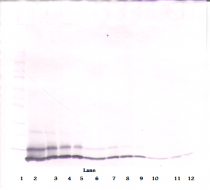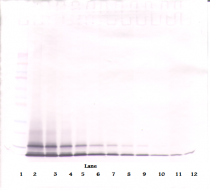ARG56636
anti-CXCL1 / GRO alpha antibody
anti-CXCL1 / GRO alpha antibody for ELISA,Western blot and Mouse
Overview
| Product Description | Rabbit Polyclonal antibody recognizes CXCL1 / GRO alpha |
|---|---|
| Tested Reactivity | Ms |
| Tested Application | ELISA, WB |
| Host | Rabbit |
| Clonality | Polyclonal |
| Isotype | IgG |
| Target Name | CXCL1 / GRO alpha |
| Antigen Species | Mouse |
| Immunogen | E.coli derived Recombinant Mouse CXCL1. (APIANELRCQ CLQTMAGIHL KNIQSLKVLP SGPHCTQTEV IATLKNGREA CLDPEAPLVQ KIVQKMLKGV PK) |
| Conjugation | Un-conjugated |
| Alternate Names | Growth-regulated alpha protein; SCYB1; Melanoma growth stimulatory activity; MGSA-a; GRO-alpha; GROa; NAP-3; FSP; C-X-C motif chemokine 1; Neutrophil-activating protein 3; GRO1; MGSA; IL-8 homologues (murine) |
Application Instructions
| Application Suggestion |
|
||||||
|---|---|---|---|---|---|---|---|
| Application Note | * The dilutions indicate recommended starting dilutions and the optimal dilutions or concentrations should be determined by the scientist. |
Properties
| Form | Liquid |
|---|---|
| Purification | Affinity purification with immunogen. |
| Buffer | PBS (pH 7.2) |
| Concentration | 1 mg/ml |
| Storage Instruction | For continuous use, store undiluted antibody at 2-8°C for up to a week. For long-term storage, aliquot and store at -20°C or below. Storage in frost free freezers is not recommended. Avoid repeated freeze/thaw cycles. Suggest spin the vial prior to opening. The antibody solution should be gently mixed before use. |
| Note | For laboratory research only, not for drug, diagnostic or other use. |
Bioinformation
| Database Links | |
|---|---|
| Gene Symbol | CXCL1 |
| Gene Full Name | C-X-C motif chemokine ligand 1 |
| Background | This antimicrobial gene encodes a member of the CXC subfamily of chemokines. The encoded protein is a secreted growth factor that signals through the G-protein coupled receptor, CXC receptor 2. This protein plays a role in inflammation and as a chemoattractant for neutrophils. Aberrant expression of this protein is associated with the growth and progression of certain tumors. A naturally occurring processed form of this protein has increased chemotactic activity. Alternate splicing results in coding and non-coding variants of this gene. A pseudogene of this gene is found on chromosome 4. [provided by RefSeq, Sep 2014] |
| Function | Has chemotactic activity for neutrophils. May play a role in inflammation and exerts its effects on endothelial cells in an autocrine fashion. In vitro, the processed forms GRO-alpha(4-73), GRO-alpha(5-73) and GRO-alpha(6-73) show a 30-fold higher chemotactic activity. [UniProt] |
| Calculated MW | 11 kDa |
| PTM | N-terminal processed forms GRO-alpha(4-73), GRO-alpha(5-73) and GRO-alpha(6-73) are produced by proteolytic cleavage after secretion from peripheral blood monocytes. [UniProt] |
Images (3) Click the Picture to Zoom In
-
ARG56636 anti-CXCL1 / GRO alpha antibody WB image
Western blot: 250 - 0.24 ng of Mouse CXCL1 stained with ARG56636 anti-CXCL1 / GRO alpha antibody, under reducing conditions.
-
ARG56636 anti-CXCL1 / GRO alpha antibody WB image
Western blot: 250 - 0.24 ng of Mouse CXCL1 stained with ARG56636 anti-CXCL1 / GRO alpha antibody, under non-reducing conditions.
-
ARG56636 anti-CXCL1 / GRO alpha antibody standard curve image
Sandwich ELISA: ARG56636 anti-CXCL1 / GRO alpha antibody as a capture antibody at 0.5 - 2.0 µg/ml combined with ARG56746 anti-CXCL1 (GRO alpha) antibody (Biotin) as a detection antibody. Results of a typical standard run with optical density.








